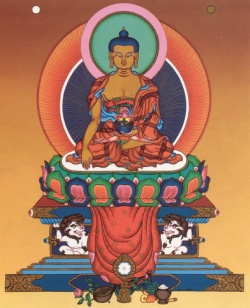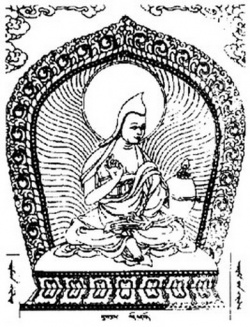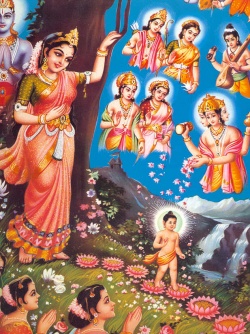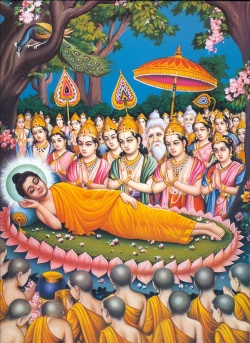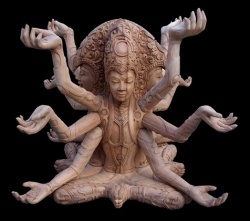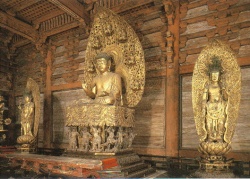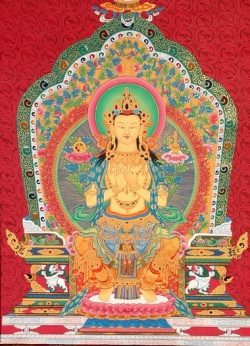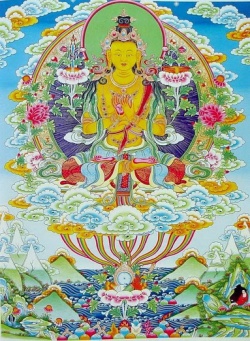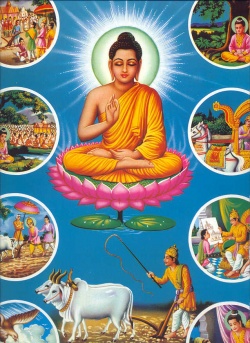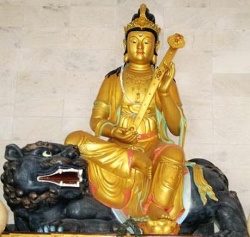Guṇaprabha’s Vinayasūtra Corpus: Texts and Contexts
by Paul K. Nietupski, John Carroll University
Abstract: This essay is a study of the corpus of texts associated with the Vinayasūtra, written by ninth-century Indian scholar Guṇaprabha, and included in the Tibetan Tengyur. The essay begins with consideration of the Sūtra format of the texts, the myths associated with the author, and continues to examine the Indian and Chinese Vinayas available to the Tibetans and their choice of the Mūlasarvāstivāda and Guṇaprabha’s Vinayasūtra corpus. These are followed with a brief discussion of the problems of manuscript availability and translation into Tibetan. The essay concludes with a brief review of the texts and their translators. The Tibetans’ choice of these texts as core documents for Tibetan Buddhism is relevant to the study of canon formation, to the institutionalization of monasticism, the place of monastic Life in Tibetan Buddhism in relation to philosophical inquiry and tantric Ritual, and to the Tibetans’ preference for Indian sources.
Introduction
This essay introduces Guṇaprabha’s Vinayasūtra and the corpus of derived Indian texts in Sanskrit fragments and in Tibetan translations, a total of six scriptures. The entire corpus is included in the Tibetan Tengyur, a Sūtra corpus among the śāstras.1 That is, the lexical format of his work is modeled on ancient Indian texts written in short aphorisms or sūtras, likely for ease of memorization and for pedagogical purposes. The text is nonetheless included in the commentarial section of the Tibetan canon, or the śāstras. This apparently innocuous detail raises questions about canon classification in India and Tibet. How was this text regarded [page 2] in India? How was it presented to the Tibetans, and why did they choose to include it in the Tengyur?
Guṇaprabha’s text seems to imitate the style of many Indian non-Buddhist Sūtra texts. Pāṇini’s (ca. fourth century BCE) Aṣṭādhyāyī begins with the statement atha śabdānuśasanam, Patañjali’s (ca. 200) Yogadarśanam begins with atha yogānuśasanam, Bādarāyana’s (ca. second century BCE) Brahmasūtra and Śaṅkara’s (788-820) Bhāṣya begin with atha brahmānuśasanam. These begin with a uniform lexical convention, atha, followed by a short statement of the contents of the work, and continue with the Body of the text in short aphorisms. Guṇaprabha likewise begins the Vinayasūtra with atha niryāṇavṛttam, which all commentators explain in great detail, and goes on to compose the text in the Indian Sūtra style. This may be because he was educated in that tradition, perhaps because he felt that his subject matter was of the same order of importance as the other great Indian works, or he may have felt that his Vinayasūtra was more properly regarded as a Buddhist Sūtra, not at all a commentarial work. Regardless of Guṇaprabha’s intentions, priorities, and the Indian canonical classifications, the Tibetans understood Guṇaprabha’s text corpus as a commentarial work, a śāstra, and included it in the Tengyur.
Indian and Tibetan styles and canonical formulations aside, the Vinayasūtra texts were eventually selected to serve as the core Tibetan monastic documents. This was a late choice; the verifiable early ninth-century translation of one of Guṇaprabha’s texts came near the end of the Tibetan Imperial period, so it is not likely that Guṇaprabha’s texts were circulated in Amdo’s eastern Vinaya, which played an important role in the late tenth-century re-establishment of monasticism in central Tibet. Even so, Amdo Vinaya was in the Mūlasarvāstivāda tradition, likely based on the only Vinaya in Tibetan Language. This made the canonization of Guṇaprabha’s Mūlasarvāstivāda-derived corpus an acceptable choice.
Guṇaprabha’s Vinayasūtra with its Autocommentary was named as one of the “Five Scriptures” (Poti Nga) and was the subject of detailed commentaries by Künkhyen Tsonawa (ca. thirteenth century), Gendün Druppa, and Butön Rinchen Drup. The importance of the text and tradition were maintained in the Tibetan grouping, but the importance of the texts in India, even if marked by the use of the Sūtra style, remains unclear.
[1] For this study I compared versions of Guṇaprabha’s works in the Degé, Peking, and Choné Tengyurs and in the existing Sanskrit versions and fragments. I have not compared the Mongolian versions of Guṇaprabha’s works. In addition, I have not been able to gain access (not for lack of trying) to the Sanskrit edition in Tibetan script of the Vinayasūtra and Autocommentary from Zhalu Monastery in western Tibet, the original currently in the possession of the China Tibetology Research Institute in Beijing, and studied and issued in facsimile by Taisho University in Japan. The incomplete reference data I have for the latter text, studies, and facsimile are: Annual of the Institute for Comprehensive Studies of Buddhism, Taisho University, 25 (2003); 26 (2004); and 27 (2005). The facsimile edition was published by Taisho University in 2001.
Who Was Guṇaprabha?
Guṇaprabha, like many Indian Buddhist authors, is a Mysterious figure. It is difficult to assess what of Guṇaprabha’s biographical data is factual and what is embellishment invented to endow him with a high level Buddhist pedigree. The inherited tradition describes him as an erudite Monk and later an abbot from a brahmin family, who lived and worked in Mathurā.2 He is called a student of [page 3] fourth-century Vasubandhu, mentor to seventh-century King Harṣa, and a contemporary of one Ratnasiṃha (ca. 649).3 His sectarian affiliations are likewise expansive, as he writes of Vinaya, is associated with Vaibhāṣikas, is called a Bodhisattva,4 is credited with authorship of commentaries on two Mahāyāna sūtras,5 his monastic texts and commentaries include Language suggestive of Mahāyāna concerns,6 and he is said to have had audiences with The Buddha Maitreya in the course of his many sojourns to Tuṣita, Maitreya’s Heaven.
The biographical details are uncertain, and beyond the suggestions in his writings it may well be that the authorities sought to authenticate Guṇaprabha by associating him with pre-eminent Buddhist figures and circumstances. The Tibetans heard these messages and revered Guṇaprabha in the list of the famous masters of Indian Buddhism, the “Six Ornaments and Two Superiors.”7 If Guṇaprabha’s pedigree is a matter of embellishment for religious ends, one might well also ask if, instead of his reputation, were the Indian Guṇaprabha’s compositions and the Tibetans’ adoption of the Vinayasūtra corpus expressive of a modified, reduced size of [page 4] medieval Indian Buddhist monasticism, perhaps the unappealing and cumbersome detail of the older and larger Mūlasarvāstivāda Vinaya, and even a reduced concern with classical Vinaya and monastic concerns?8 If this was the case in India, were the Tibetan motives for adopting the corpus as Davidson suggests, namely that monastic concerns were less of a priority in Tibet? The study of Guṇaprabha and his texts along with the recent studies on early Tibetan Buddhism can shed some Light on the nature of Indian and Tibetan religions and institutional development.
[2] See l. Chimpa and A. Chattopadhyaya, trans., Taranatha’s History of Buddhism in India (Simla: Indian Institute of Advanced Study, 1970), 176; S. A. Banerji, Traces of Buddhism in South India: 700-1600 A. D. (Calcutta: Scientific Book Agency, 1970), 95; D. K. Barua, Vihāras in Ancient India: A Survey of Buddhist Monasteries (Calcutta: Indian Publications, 1969), 89.
[3] Guṇaprabha, Vinayasūtra and Autocommentary on the Same by Guṇaprabha, ed. P. V. Bapat and V. V. Gokhale (Patna: K.P. Jayaswal Research Institute, 1982), xxii states that this mention of Ratnasiṃha “…may be a marginal remark of some later reader of the text.” The Vinayasūtra and Autocommentary, xxii, quotes J. Takakusu, A Record of Buddhist Religion as Practised in India and the Malay Archipelago, AD 671-695. 2nd Edition (New Delhi: Munshiram Manoharlal, 1982), LVIII, 184: “I-tsing mentions one Ratnasiṃha as living then at Nālandā at about 649 A.D.”
[4] In the opening of the Vinayasūtra Autocommentary.
[5] Guṇaprabha, Byang chub sems pa’i sa’i ’grel pa [*Bodhisattvabhūmivṛtti] and Byang chub sems pa’i tshul khrims kyi leu’i bshad pa [*Bodhisattvaśīlaparivartabhāṣya], in The Tibetan Tripiṭaka: Peking Edition, Vol. 112, ed. D. T. Suzuki (Tokyo: Tibetan Tripitaka Research Institute, 1955).
[6] Guṇaprabha, Vinayasūtra, xliv remarks: “There is a reference to vajropamāSamāpatti (Sūtra 1) before attaining sopadhiśeṣanirvāṇa. This may well indicate the author’s Mahāyānism.” See the passage “…even those endowed with Compassion amongst those in this World with human bodies in fortunate circumstances have many numbers of impurities, obstacles, and ugliness”: anukampakaiḥ dṛṣṭi [T. kṣāṇa] saṃpanne ca manuṣyatve bahavo ’tra, Guṇaprabha, *Vinayasūtravṛttyabhidhānasvavyākhyānam (Guṇaprabha, Vinayasūtra and Autocommentary, 13.3); thugs brtse ba dang ldan pa rnams kyis dal ’byor phun sum tshogs pa’i mi’i lus nyid ’di la/, Guṇaprabha, ’Dul ba’i mdo’i ’grel pa mngon par brjod pa rang gi rnam par bshad pa, in the Degé Tengyur Series, vol. 161, no. 12, zhu (New Delhi: Delhi Karmapae Chodhey, 1986), 12b.6. See references to various types of Bodhi in the closing pages of the *Vinayasūtravṛtti attributed to Guṇaprabha. See Guṇaprabha, ’Dul ba’i mdo’i ’grel pa, in the Degé Tengyur Series, volume 165, no. 16, lu (New Delhi: Delhi Karmapae Chodhey, 1986), 343a.3 ff: “sangs rgyas kyi sku/”; see the discussions of śīla and Samādhi (Guṇaprabha, ’Dul ba’i mdo’i ’grel pa, 21); see Guṇaprabha, ’Dul ba’i mdo’i ’grel pa, 16b.5: dgra bcom pa dang rang sangs rgyas la mi byao bla la med pa’i sangs rgyas pas na yang dag rab mkhyen [ce]s so/; see The First Dalai Lama, Dge ’dun grub pa, Legs par gsungs pa’i dam pa’i chos ’dul ba mtha’ dag gi snying po’i don legs par bshad pa rin po che ’phreng ba, in The Collected Works of the First Dalai Lama dge ’dun grub pa, vol. 1 (Gangtok: Dodrup Lama Sangye, Deorali Chorten, 1981), 55b.6: brtul zhugs can gyis bla ma bas/; see Shes rab bzang po, Kun mkhyen mtsho sna ba, ’Dul ba mdo rtsa’i rnam bshad nyi ma’i ’od zer legs bshad lung gi rgya mtsho (Karnataka: Drepung Losel Ling, n.d.), 62a.3: brtul gshug can/. See Shes rab bzang po, ’Dul ba mdo rtsa’i rnam bshad for extensive comments on Mahāyāna themes, for example pakpé tsültrim (Shes rab bzang po, ’Dul ba mdo rtsa’i rnam bshad nyi ma’i ’od zer legs bshad lung gi rgya mtsho, 73b.1 ff). See Guṇaprabha, ’Dul ba’i mdo’i ’grel pa, 9a.4: snying rje che ba/.
[7] Nāgārjuna, Āryadeva, Asaṅga, Vasubandhu, Dignāga, and Dharmakīrti (fl. ca. seventh century) are the Six Ornaments. Śākyaprabha and Guṇaprabha are the Two Superiors.
[8] See Georges Dreyfus, The Sound of Two Hands Clapping: The Education of a Tibetan Buddhist Monk (Berkeley: University of California Press, 2003), where the author describes the relative marginalization of the Vinaya documents in modern Tibetan Buddhism; Vinaya texts do not represent modern Tibetan monastic practice. Davidson makes a similar assessment of Tibetan priorities and behavior in the ninth century and later, suggesting at times rather little concern for strict monastic discipline (Ronald M. Davidson, Tibetan Renaissance: Tantric Buddhism in the Rebirth of Tibetan Culture [[[Wikipedia:New York|New York]]: Columbia University Press, 2004], 120-122). Perhaps a similar scenario served as a motive for Guṇaprabha’s abbreviated composition, and for its adoption by the Tibetans.
What Vinayas Were Available to the Tibetans?
The Chinese translations show that there were a number of Indian Vinaya collections available in the fifth century, some of which were also later available to the Tibetans (remembering for example that Atiśa [980-1054] was in the Mahāsāṅghika system). The Tibetans had contacts with the Chinese Buddhists in the seventh to eleventh centuries, and they did indeed translate a number of Chinese Buddhist texts, but they did not in general consider Chinese translations as sources for the Tibetan Buddhist canon, disregarding the extensive corpus of Vinaya materials in Chinese.9 This is made evident by the fact that the Chinese translated at least five Vinayas, four in the early fifth century,10 and a number of texts of Mūlasarvāstivādin in the late seventh or very early eighth century, by Yijing (ca. 635-713), all of which went unrecognized by the Tibetans.
There is also no evidence that Guṇaprabha’s texts were translated into Chinese. Given their importance in Tibet, and presumably in India, the absence of Guṇaprabha’s Vinayasūtra texts, like some philosophical texts (of Candrakīrti [fl. 600-650], Dharmakīrti, and others, for example) is odd, but might be merely a matter of timing. Davidson suggests that the majority of Chinese pilgrims visited India before the development of those religious movements and that the philosophical and monastic texts not included in the Chinese canons had not yet been composed or at least not widely circulated.11 Otherwise, if there was a later stream of Chinese pilgrims, the lack of these materials in Chinese was a matter of [page 5] accessibility, or because they were overlooked or ignored by the Chinese pilgrims and translators.
The Tibetans only translated the Mūlasarvāstivāda Vinaya, the longest Vinaya, in the eighth century, and Guṇaprabha’s summary texts later. The early translation signals the Imperial adoption and later eastern Tibetan monastic preservation of the Mūlasarvāstivāda system. The subsequent Tibetan choice of the Mūlasarvāstivāda and later works by Guṇaprabha may have been a matter of sectarian popularity of that system in eastern Tibet and in India, to the intentional exclusion of other Indian systems and of the extensive Vinaya collections in Chinese. If so, the Tibetan exclusive translation and adoption of Mūlasarvāstivāda and derived texts makes sense, and marks a consensus among Tibetan religious authorities.
Alternatively, was the Tibetan adoption of Mūlasarvāstivāda-derived texts more by circumstance, merely a matter of availability of canonical texts made popular in the places where they acquired their materials, less a matter of sectarian consensus among Tibetans? Frauwallner speculated that different Vinaya systems were based on the realities of distance between Buddhist missions, which may have had earlier common sources but over time developed monastic and doctrinal differences.12 If this was the case, the Tibetan selection of the Mūlasarvāstivāda and later Guṇaprabha’s corpus was not at all a conscious religious or doctrinal choice, but merely a matter of regional availability. The source places for early Tibetan Buddhist materials are generally known, for example, Nepal, Kashmir, and Bengal, but if regional availability was a determining factor, it indicates that Tibetan Buddhists were adopting a specific regional system or systems piecemeal, and not at all comparing, collating, or fully editing materials from a pan-Indian Buddhist tradition. This means that the choice of Mūlasarvāstivāda was not as much of a choice as a matter of chance.
In support of this, regional Vinaya traditions in India are noted by Frauwallner, who wrote that in addition to the Pāli Vinaya in Śrī Laṅkā, “[t]he Vinaya of the Mūlasarvāstivādin would be the Vinaya of Mathurā, and that of the Sarvāstivādin the Vinaya of Kaśmīr …and Gandhāra.” He further notes that “the earliest translators of Vinaya texts of the Dharmaguptaka into Chinese were the Sogdian K’ang Seng-k’ai and the Parthian T’an-ti,”13 and Dutt speculates that the Mahāsāṅghika were based in Mathurā or Kaśmīr.14 These scholars make a case for the Mūlasarvāstivāda and possibly the Mahāsāṅghika Vinaya being current in the places Tibetan translators searched for canonical documents. This argument is further corroborated somewhat by the facts that Guṇaprabha’s legendary home was Mathurā, and his important Autocommentary is also known as the “Mathurā [page 6] Commentary.”15 The choice or rather chance adoption of Mūlasarvāstivāda and Guṇaprabha might indicate the prominence of Mathurā over Kaśmīr and Bengal as a primary source place for the Tibetan Vinaya, even in Light of the well known importance of these latter sites in Tibetan Buddhist history.
[9] See the early lists of Chinese texts translated into Tibetan in Georgios Halkias, “Tibetan Buddhism Registered: A Catalogue from the Imperial Court of ’phang thang,” The Eastern Buddhist 36, nos. 1-2 (2004): 66, 99-100.
[10] E. Frauwallner, The Earliest Vinaya and the Beginnings of Buddhist Literature (Rome: Serie Orientale Roma, 1956), 1-2 lists the Vinayas in Chinese translations: “the Sarvāstivādin, Dharmaguptaka, Mahīśāsaka, Mahāsāṅghika, [and the] …Mūlasarvāstivādin.” See Jan Nattier, A Guide to the Earliest Chinese Buddhist Translations: Texts from the Eastern Han and Three Kingdoms Periods (Tokyo: The International Research Institute for Advanced Buddhology, Soka University, 2008), 3.
[11] Davidson, Tibetan Renaissance, 125.
[12] Frauwallner, Earliest Vinaya, 12. See Nalinaksha Dutt, The Early History of the Spread of Buddhism and the Buddhist Schools (New Delhi: Rajesh Publications, 1980), 110-123.
[13] Frauwallner, Earliest Vinaya, 1-23, 37 ff.
[14] Dutt, The Early History, 132-136.
[15] ’Dul ba’i mdo’i ’grel pa bcom brlag ma zhes bya ba [[[Wikipedia:Mathurā|Mathurā]] Commentary] (Guṇaprabha, ’Dul ba’i mdo’i ’grel pa mngon par brjod pa rang gi rnam par bshad pa, 273b.5).
Translations
The difficulties in terminology in the translated texts and the source manuscripts in Indian languages signal the fact that the texts are likely descriptive of an Indian monasticism of a past time, realities unfamiliar to the Tibetan translators, even their Indian mentors, and sometimes difficult to express in Tibetan Language. Moreover, the then current Indian Monasteries and their supporting communities were under increasing social, economic, and political pressure from the eighth to twelfth centuries and as a result the Buddhist monastic systems often fragmented or inconsistent. Finding a single, consistent, pan-Indian Buddhist monastic system in Mathurā, Nepal, Kaśmīr, and Bengal was likely impossible.16
Another difficulty was the availability of reliable texts. Many Indian manuscripts of the day were negatively impacted by scribal and copyist error, imperfect memory, poor editing of fragments, lack of sponsorship, and others. Further, the fact that the script of the available Sanskrit manuscript is not standard devanagari, difficult for modern scholars and as Davidson points out, likely difficult for early Tibetans faced with a large variety of texts in different scripts and even different languages.17
The Language of the Vinayasūtra verses and the Autocommentary (the former complete in Sanskrit and Tibetan translations, the latter in Sanskrit fragments and complete Tibetan translation), the two texts considered the most important in the Tibetan Vinaya, are not in perfect grammatical Sanskrit. The unedited Sanskrit of the Autocommentary is anomalous, since the compositions are based on solid Knowledge of ancient Vinaya documents, and the legends of Guṇaprabha refer to him as a brahmin, a master of Indian Religion, philosophy, secular sciences, and likely Sanskrit Language. His command of Buddhist and Indian literature is evident in the Autocommentary, as is his awareness of Indian Buddhist history. On many occasions he refers to other Buddhist texts, Brahmanical theories, technicalities of Sanskrit grammar, and different practices and procedures in The History of Buddhism.
The anomalies in the Language of the Autocommentary are a product of the chaotic trans-Himālayan translation environment. In addition to the difficulties of the classical Sūtra and commentary style the Autocommentary shows problems of human error, perhaps different languages, scripts, and grammatical conventions. [page 7] For example the Autocommentary overuses the Sanskrit convention for quotations (iti). Does this indicate an oral commentary, or is the text complied from other sources, from versions of the Mūlasarvāstivādavinaya? Oral recitation might be marked by occasionally rough syntax, the overuse of the Sanskrit substantive suffixes -tā and -tva, numerous references to what “the Master said” throughout the text, and prominently, the expression “oral commentary” at the beginning of the Vinayasūtra. If orally circulated, there may have been a small number of copies of his works, and a possible reason for the less than eloquent style and syntax, not to mention inaccurate classical saṃdhi rules. There are variant readings, and different passages in the versions of the Vinayasūtra and Autocommentary quoted in the Vṛtti that indicate that there may have been different versions of the Vinayasūtra available to different translators at different times and in different places, not a surprising scenario.18
In sum, it appears that the problems of Language, manuscript availability, memory and others applied in the case of the Autocommentary, but less in the case of the Ṭīka. It seems however that the problems were more a case of Indian manuscripts and not the fault of the translators or other factors faced by ninth-century Jinamitra (fl. ca. 824) and Chokro lü Gyentsen (ninth century; Vinayasūtra and Ṭīka) or of twelfth-century Alaṃkāradeva and Tsültrim Jungné Bepa (ca. 1107-1190; Autocommentary), who are widely known for their accurate translations. We can see that they were faithful to the Sanskrit versions of the Vinayasūtra and Autocommentary, and by their reputations and readability of the texts, we can assume that their sources for the Ṭīka were in relatively better shape. The translators, source texts, translations and thus the degrees of accuracy of the Vṛtti and the Vyākhyāna are unknown.
[16] Davidson has discussed the state of manuscripts and translations in detail. See Davidson, Tibetan Renaissance, 84-128.
[17] The editors Bapat and Gokhale do not identify the script of the Autocommentary, perhaps a śarada script. See Davidson, Tibetan Renaissance, 127-128.
[18] For example, in the first Sūtra: atha niryāṇavṛttam (Guṇaprabha, Vinayasūtra and Autocommentary, 3.6, 3.7, 3.19-20); de nas nges bar ’byung ba’i tshul ’khrims kyi dbang du byas te/ (Guṇaprabha, ’Dul ba’i mdo’i ’grel pa mngon par brjod pa rang gi rnam par bshad pa, 1a.3). Guṇaprabha, *Vinayasūtravṛtti, 1a.1: gtogs pa nges par theg pa’i tshul te/ for atha niryāṇavṛttam in the Vinayasūtra and Autocommentary Sanskrit edition. In Prajñākara, ’Dul ba mdo’i rnam par bshad pa, in the Degé Tengyur Series, volume 164, #15, ru (New Delhi: Delhi Karmapae Chodhey, 1986): nges par theg pa’i tshul du gtogs pa ste/. These latter two texts use nges par theg pa for niryāṇa, instead of the more common nges bar ’byung ba. There are also terms in the texts that do not appear in the Mahāvyutpatti lexicon. See for example Guṇaprabha, ’Dul ba’i mdo’i ’grel pa, 12a.2, 12a.5, 12b.5: mur ’dug pa here and throughout for mu stegs pa; not in Mahāvyutpatti.
Texts
Guṇaprabha’s root text, the Vinayasūtra, is composed in sūtras or “aphorisms,” terse statements possibly designed to function as mnemonic devices; they are not written in any regular meter. The text is based on the Mūlasarvāstivāda Vinaya, and includes many references to the specifics of the Prātimokṣa, Sūtravibhaṅga, Karmavācanā, and Skandhaka from that system. The seventeen chapters of Guṇaprabha’s work correspond to the seventeen topics of the Skandhaka. Bapat pointed out that Guṇaprabha chose the Vinayavastu as the framework for his Vinayasūtra, but his Vinayasūtra “…covers the whole field of Vinaya–the [page 8] Prātimokṣa, along with its commentary, Vibhaṅga, and the Khandakas.”19 For example, in the Renunciation Section (Pravrajyāvastu) of the Vinayasūtra, Sūtra 76, Guṇaprabha included the penalties for violations of Community Meeting rules from the Mūlasarvāstivāda Prātimokṣa/Sūtravibhaṅga.20 The extent and sources of numerous inclusions are discussed in the Introduction to Bapat and Gokhale’s edition of the Vinayasūtra and the Autocommentary.21 This shows that Guṇaprabha’s texts can be understood as an abbreviated version of the Mūlasarvāstivāda Vinaya, reflecting what were considered essential elements of the earlier text. There is a complete Sanskrit version of this text, identical or at least very close to the versions embedded in the extant Sanskrit fragments and translated Tibetan commentaries.22
Guṇaprabha’s own commentary on his Vinayasūtra is the Autocommentary (Vinayasūtravṛttyabhidhānasvavyākhyāna). The colophon of the Autocommentary records that the text was translated into Tibetan by the twelfth-century translators Alaṃkāradeva and Tsültrim Jungné Bepa. It was composed in the Pel Sanyi Palace,23 and translated in Wentsa Temple24 in a Dharma center25 at the base of Pel Gyeu Mountain. The Autocommentary is often terse, but can often be clarified by reference to Dharmamitra’s Ṭīka.
The Vinayasūtra and the Autocommentary are similar in style. The two texts flow together well, the commentary following the sequence of the sūtras. The Autocommentary is however a difficult text. The author’s Mastery of the Language and concepts are evident throughout, but the comments are sometimes terse, and editing of the available manuscript is poor.
The third text in the Vinayasūtra series, *Vinayasūtravṛtti, is attributed to Guṇaprabha, though the colophon suggests that it was a compilation of several scholars.26 It is interesting to speculate what this means and how the composition [page 9] of the text took place. The Vṛtti is very different in style than the above two texts, the Vinayasūtra and the Autocommentary. It is wordy and explicit, unlike the terse and sometimes technical Language of Guṇaprabha’s other texts. In addition, the general vocabulary of the Vṛtti is different from that in Guṇaprabha’s other texts and Dharmamitra’s Ṭīka. For example, it contains Buddhist terms not found in Guṇaprabha’s other works or in Dharmamitra’s Ṭīka.27 My conclusion is that this text, while attributed to him, and definitely unpacking the subtleties of the Vinayasūtra, is probably a compilation of teachings on the Vinayasūtra, and prepared by disciples or translators.
The Vṛtti is stylistically different from the other two Vinayasūtra texts attributed to Guṇaprabha, but is stylistically similar to Prajñākara’s Vinayasūtravyākhyāna.28 Both of these commentaries are in straightforward prose, clear and concise, and easy in style, giving insightful interpretations of Guṇaprabha’s works. The Vyākhyāna is a valuable commentary in its own right, though little is known of Prajñākara or his text. Both of these texts, the Vṛtti and the Vyākhyāna do not reproduce the Vinayasūtra and Autocommentary in their entirety, but follow the line of reasoning closely, giving paraphrases of the original.
Of all the commentaries, Dharmamitra’s Ṭīka29 follows the Vinayasūtra and Autocommentary the closest. Dharmamitra was possibly a Tokhārian scholar and reputedly a student of Guṇaprabha, though there is no corroborating evidence for this claim. He is identified in the colophon as a Vaibhāṣika Master of a place called Togar. The colophon goes on to state that his Ṭīka was translated into Tibetan at the request of Pellha Tsenpo, as noted above, by the Ācārya, Jinamitra, and the Tibetan translator, Chokro lü Gyentsen.
Though the Ṭīka omits passages from time to time, it follows the Vinayasūtra and Autocommentary closely, Offering in-depth explanations of key points. The version of the sūtras in the earlier (ninth century) translated Ṭīka is identical to the later-translated (twelfth century) Vinayasūtra and Autocommentary. The Language of the Ṭīka is very refined, with accurate grammar and correct usage of semantic devices. It contains a Wealth of Information. Its style resembles that of the Vinayasūtra and Autocommentary, unlike that of the Vṛtti and the Vyākhyāna.
The translation sequence of these texts is itself odd. Even though the Autocommentary is regarded as the core document for Tibetan Buddhist monasticism, as is shown in the native Tibetan commentaries, Guṇaprabha’s Vinayasūtra and Dharmamitra’s Ṭīka were translated into Tibetan first by Jinamitra,30 a Kaśmīri expert in Mūlasarvāstivāda Vinaya, and Chokro lü Gyen [page 11] tsen, in the early ninth century. The more important – to the Tibetans – Autocommentary was translated later, in the twelfth century, by Alaṃkāradeva and Tsültrim Jungné Bepa.31 The sequence of translation as we have it before us does not correspond to the prominence given to the Autocommentary by the Tibetans, or it may signal the Evolution of monasticism in Tibet, as the more important text was not translated until the twelfth century.
The last known32 commentarial text on the Vinayasūtra is the Vinayakārikā (also known as Āryamūlasarvāstivādavinayakārikā PuṣpamālāNāma) by Viśākhadeva, a Disciple of Saṃghadāsa, who was said to be a contemporary of Vasubandhu.33 This association with Vasubandhu creates the same problem as for Guṇaprabha. If Guṇaprabha lived in the Post Gupta Dynasty Viśākhadeva could hardly have written about his text. There is little data for the precise dating of Viśākhadeva.
This text, the Puṣpamālā, is included in the list of commentaries on the Vinayasūtra, but is in fact not a commentary but a kārikā summary of the contents of the Vinayasūtra. Though useful in its own right as an independent treatise, the Puṣpamālā is of little use for understanding the Vinayasūtra texts and commentaries.34
[19] P. V. Bapat, “Discovery of a Sanskrit Text: Vinaya Sūtra,” in Proceedings of the Twenty-Sixth International Congress of Orientalists, New Delhi, January 4-10, Vol. 3, Part 1 (Poona: Bhandarkar Oriental Research Institute, 1969), 343.
[20] Guṇaprabha, Vinayasūtra and Autocommentary, 14.15-17; Guṇaprabha, ’Dul ba’i mdo’i ’grel pa mngon par brjod pa rang gi rnam par bshad pa, 14a.5.
[21] Guṇaprabha, Vinayasūtra and Autocommentary, xxiii-xxv.
[22] Guṇaprabha, Vinayasūtra of Bhadanta Guṇaprabha, ed. Rahul Sankrityayana (Bombay: Bharatiya Vidya Bhavan, 1981).
[23] Dpal sa nyi’i gtsug lag khang chen por/ (Guṇaprabha, ’Dul ba’i mdo’i ’grel pa mngon par brjod pa rang gi rnam par bshad pa, 273b.6-7). The next passage has a long Epithet, not uncommon among Indian kings: rje btsun dam pa rgyal po chen po’i yang chen po dbang phyug dam pa dpal tshul khrims nyi ma’i lha rab tu rgyas par gyur pa rnam par rgyal ba’i rgyal srid kyi lo la bris pa yin no/ (Guṇaprabha, ’Dul ba’i mdo’i ’grel pa mngon par brjod pa rang gi rnam par bshad pa, 273b.7).
[24] Dben tsha’i gtsug lag khang / (Guṇaprabha, ’Dul ba’i mdo’i ’grel pa mngon par brjod pa rang gi rnam par bshad pa, 274a.7).
[25] Chos skor/ (Guṇaprabha, ’Dul ba’i mdo’i ’grel pa mngon par brjod pa rang gi rnam par bshad pa, 274a.7).
[26] Also called the ’Grel chung in Tibetan. The translators of this commentary, the *Vinayasūtravṛtti, are not specified in the colophon of the text. See Guṇaprabha, ’Dul ba’i mdo’i ’grel pa, 344a.7: ’dul ba’i mdo’i rtsa ba’i ’grel pa chung ba slob dpon mang du thos shing yon tan dang ldan pa yon tan gyi ’od thams cad yod par smra ba pas byas pao/.
[27] See above and also Guṇaprabha, ’Dul ba’i mdo’i ’grel pa, 342b.1-344a.7.
[28] The colophon in this text makes no mention of its translators from Sanskrit to Tibetan.
[29] ’Phags pa gzhi thams cad yod par smra ba’i ’dul ba kun las btus pa’i rgya cher ’grel pa/, Dharmamitra, ’Dul ba’i mdo’i rgya cher ’grel pa, in the Degé Tengyur Series, 162, 13, ’u (New Delhi: Delhi Karmapae Chodhey, 1986), 390a.5.
[30] See A. Kaul, Buddhist Savants of Kashmir: Their Contributions Abroad (Srinagar: Utpal Publications, 1987), 33-5, 69-70. For Chokro lü Gyentsen, see David S. Ruegg, The Literature of the Madhyamaka School of Philosophy in India (Wiesbaden: Otto Harrassowitz, 1981), 69n, 85n, 86n.
[31] These dates are tentative, though the translators were most likely active in the twelfth century. See Grags pa ’byung gnas, Gangs can mkhas grub rim byon ming mdzod (Lanzhou: Kan su’u mi rigs dpe skrun khang, 1992), 767-769.
[32] Priya S. Singh, “The Vinayasūtra of Guṇaprabha: A Historical Note,” in Buddhist Studies: The Journal of the Department of Buddhist Studies 10 (New Delhi: University of Delhi, March, 1986).
[33] Chimpa and Chattopadhyaya, Taranatha’s History, 150; it was translated into Tibetan by Jayakara, Prajñākīrti (Taranatha says that Prajñākīrti was from Nyeltsor, 197, n.10-12), Vānaratna, and Rongtön.
[34] The modern Tibetan tradition describes the Vinayasūtra text history, with comments on other Vinaya materials: “The Master Guṇaprabha composed the actual nine-sectioned Vinayasūtra, and second, the nine-sectioned Karmaśataṃ. His Disciple was the Master Dharmamitra, who composed the *Vinayasūtraṭīka in seventy sections. Furthermore, Guṇaprabha is credited with the Vṛtti of that very Sūtra, the Short Commentary. There are [also] the Indian texts composed by Prajñākara, the short commentary composed by Vimalamitra, and one composed by Śākyaprabha… Kalyāṇamitra composed a commentary on the vastus (lungzhi) and points of inquiry (zhuwé drelpa). Vimalamitra [composed] a commentary on the Prātimokṣasūtra in fifty sections, [and] in particular, Mitra [composed] the Sosor Dündrel. Vinitadeva composed a commentary on the Vibhaṅga, and Śīlapālita composed a commentary on the Kṣudraka.” Sönam Drakpa, Dülwé Chönjung [History of Vinaya) (Dharamsala: Library of Tibetan Works and Archives, 1975), 18.4-24.4.
Conclusion
Guṇaprabha’s three texts, Dharmamitra’s Ṭīka and Prajñākara’s Vinayasūtravyākhyāna make up the core of the Vinayasūtra corpus. They were evidently translated at different times and places, suggesting that not all of these texts were available to the Tibetans at the same time. The texts are nonetheless a coherent collection and represent a collective attempt to define Tibetan monasticism.
The answers the texts provide are intriguing, and yet the texts raise further interesting questions. Monasticism was a part of Buddhism in Tibet, but it was only gradually institutionalized, signaled by the adoption of Guṇaprabha’s summaries, and their gradual rise in importance. The exact nature and extent of ninth to twelfth-century Indian and Tibetan Buddhist monasticism remain topics for further research. There are reports of monastic ordinations and evidence of Monks and Monasteries in Tibet, but routine Rituals were likely not exactly similar to those described in Guṇaprabha’s texts, suggesting that Indian monasticism as represented in the literature only gradually evolved into a distinctively Tibetan institution.
